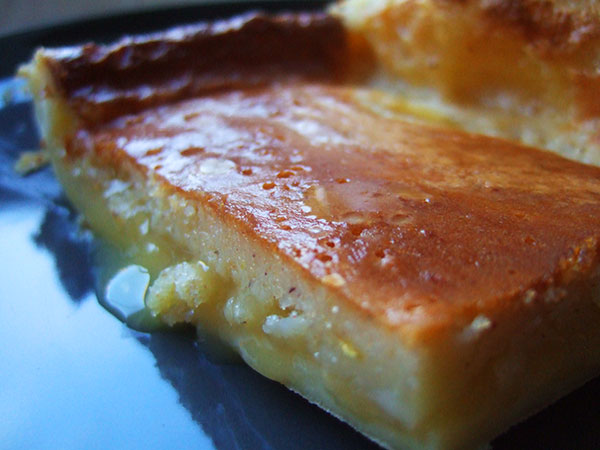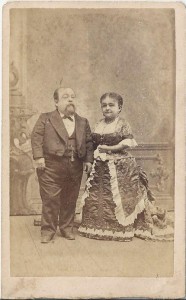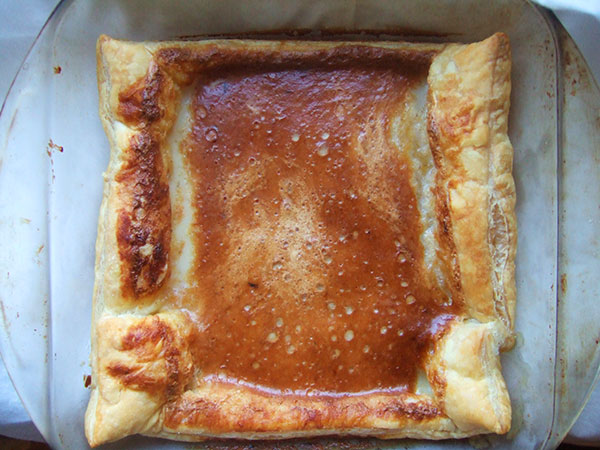 A cheesecake recipe for a 19th century Photographer.
A cheesecake recipe for a 19th century Photographer.
The History
College was one of the most difficult and demanding times of my life. I looked for small ways to escape the pressure, like ducking into Attenson’s Antiques on Coventry, a maze of rooms stuffed with treasures. In the back corner was a bookshelf used as a dumping ground for an ever-growing collection of photographs. Box after box, picked up at estate sales, ended up in this nook. If the day was quiet enough, the shop owners would let me spread out on the floor to go through the black and white lives of people long dead. After an hour or two, I’d have a pile of images set aside. I’d pay ten or twenty dollars, and take my new friends home.

An albumen print of General Tom Thumb and his wife, Lavinia.
If you’ve ever spent time sorting through thrift store images, you’ve certainly come across a type of photography known as albumen printing. Albumen photographs are characterized by their sepia tone, glossy sheen, and sometimes a metallic shine in the dark parts of the image. They’re also printed on a thin piece of paper glued to a thicker cardboard stock.
Albumen is made of egg whites. This sticky substance allowed photographer to adhere photo chemicals to glass plates, allowing for the first commercially viable form of reproducible photography. Additionally, when painted on paper, albumen created an ultra smooth surface on which to float photosensitive chemicals; the result was a highly detailed image when the photo was printed.
The process was revolutionary and used for much of the second half of the 19th century, and even into the 20th. However, producing albumen paper used a lot of eggs whites and left a byproduct of a ton of egg yolks. Some of those yolks could have been used in this recipe for “Photographer’s Cheesecake” published in The Wilder Shores of Gastronomy: Twenty Years of Food Writing.
.
The Recipe
In 1861, The British Journal of Photography suggested, to the amateur photographer, that he could use his excess egg yolks to make a cheese cake. One day, after making a meringue, I had a lot of yolks on my hands and decided to give it a try. It required very few ingredients and took less than ten minutes to assemble. Problems started to arise when I baked it: the filling was still liquid although I had baked it longer than the recipe suggested. When I put it in the fridge overnight, it was solid, but liquefied at room temperature. I still ate it, though.
The Photographer’s Cheesecake
Originally printed in The British Journal of Photography, 1861
Reprinted in The Wilder Shores of Gastronomy
To convert the yolks of eggs used for albumenizing to useful purposes: Dissolve a quarter of a pound of butter in a basin placed on the hob, stir in a quarter of a pound of pounded sugar, and beat well together; then add the yolks of three eggs that have been previously well-beaten; beat up altogether thoroughly; throw in half a grated nutmeg and a pinch of salt; stir, and lastly add the juice of two fine-flavoured lemons, and the rind of one lemon that has been peeled very thin; beat all up together thoroughly and pour into a dish lined with puff-paste, and bake for about twenty minutes. This is a most delicious dish.
1 stick butter, softened
1/2 cup sugar
3 egg yolks, beaten
1/2 of a freshly grated nutmeg
Pinch of Salt
Juice of two small lemons
Zest of one lemon
Puff Paste (store bought is ok!)
Beat (using an electric mixer, if you like) butter and sugar until light and fluffy. Add egg yolks, one at a time, mixing after each addition. Add nutmeg and salt; mix. Add lemon juice and zest; mix. Pour into a baking dish lined with puff paste, bake at 350 degrees for 35 minutes.
The Results
 Out of the oven.
Out of the oven.
Honestly, it tasted great! I loved the citrus, which complemented the nutmeg well. At the same time, the technical aspects of the recipe didn’t work. It was goopy and runny and not at all right–and I don’t think it was my mistake. perhaps this recipe was originally published as a joke, not as a real recipe? Which seems silly, because what on earth did those photographers do with all those egg yolks anyway?

Too much lemon!
Do you think lemons always used to be these giant things the size of your fist? They used to be the size limes are now, and with much less juice. Halve or quarter the juice and it might work a bit better.
Their taste for spices was so different than ours as well. That’s a crazy proportion of nutmeg.
I was intimidated by the quantity of nutmeg, so I used a little less–1/4 of a nutmeg instead of a half. Yes, the lemons would have been smaller–but this is 100 years ago, not 500 years ago, so I don’t think they would be crazy small. Overall, I was surprised by how much I liked the flavor of the filling. It wasn’t overpowering!
I love this photographic history meets food history.
and I love photo history, so this delighted me too!
Another thought or two–if it a cheesecake, where’s the cheese? Or dairy? Those cheesecakes I have made have mass amounts of cream cheese, or even cottage cheese in some of the more odd ones. Also, the “pounded sugar”– any chance it could be powdered sugar? Not sure when corn starch was first added to powdered sugar, but if it fits with the recipe, it is a natural thickener and may help hold it together better.
I know!! I got finished making this and I though the same thing–where’s the cheese? Pounded sugar is likely to be super fine sugar, not powdered. I think this needs some more research to see if there’s a better version of this recipe out there; because as is, it doesn’t make a whole lot of sense.
“Pounded sugar” was simply chunks of cone sugar/loaf sugar pulverized in a mortar or on a table. As such, it was always from sugar cane and pretty similar to the large crystal “raw sugar” sold today. An essential tool in the Victorian kitchen was a pair of sugar nippers to bite off those chunks, and maybe a second coffee grinder to make a coarse first grind of the sugar if you needed lots of it. You’ll also see 19th c. recipes calling for “fine pounded sugar,” which meant that it should be sifted through a flannel bag to remove impurities, or better yet, clarified.
I had been curious about that. Thanks Chef!
Over the summer I saw a great talk about sugar production in the 18 the century. Apparently, white sugar was quite pure by that time. The cone shape came from the cone molds the sugar syrup was poured in to crystallize, and it allowed molasses and other impurities to drip out a hole in the cone’s tip. Additionally, this recipe is only from about a century ago. Although it references pounding what is presumably cone sugar, there was granulated white sugar available– the process was invented in the 1860s.
Sarah, did the speaker make a distinction between granulated sugar and castor sugar? The former was coined, I believe, when sugar was first sold loose to dodge a tax or tariff on loaf sugar. Castor/caster sugar references first appear in 1860s cookbooks but was apparently the same as “crushed sugar,” which is a much older term. From Miss Beecher’s Domestic Receipt-book (1846): “It is best to keep four qualities of sugar on hand. refined loaf for tea, crushed sugar for the nicest preserves and to use with fruit, nice brown sugar for coffee and common brown for cooking and more common use.”
The granulated sugar stuff actually came from here: http://www.foodtimeline.org/foodcandy.html#aboutsugar
And you’re probably right–the sugar would have been in a “loaf” or cone shaped, I just wanted to make it a point that it was quite lovely and white by the 1860s.
I’m only an amateur foodie, so this may be a silly question: is it possible that using an electric mixer caused the problem? Could the extra incorporated air be responsible?
It’s a good thought, but I don’t think so. I think there was a mistake in the recipe, which is not uncommon in 19th c texts. Perhaps an ingredient was left out, or a proportion was wrong. Or perhaps I made a mistake in translating it for a modern kitchen! It’s hard to say.
Pingback: Seeing Moons | Phase Box: Conservation by Damen Joe at Auckland Libraries
Pingback: The Photographer’s “Cheesecake” – 1862 » The Food Beat
This looks just like a Philadelphia butter cake, which is intentionally gooey—and friggin’ delicious. However, the crust is yeast-risen. If you can call this cake “risen”—it’s flat as, um, a pancake, and in fact bakeries sell it in its baking pan, because it can’t really be removed. There’s the corpse of one on my desk right now, and everything nearby is sticky with sugar, because though one intends to eat it with a fork from a plate, one really just scoops it out, compulsively, all day. You can find recipes online.
I want to eat this food next time I’m in Philly! Is there a bakery you’d recommend?
I like Danish Bakers’ butter cake. McMillan’s, in close-by Westmont, NJ, makes a mean butter cake, too. I hope you get to try one soon!